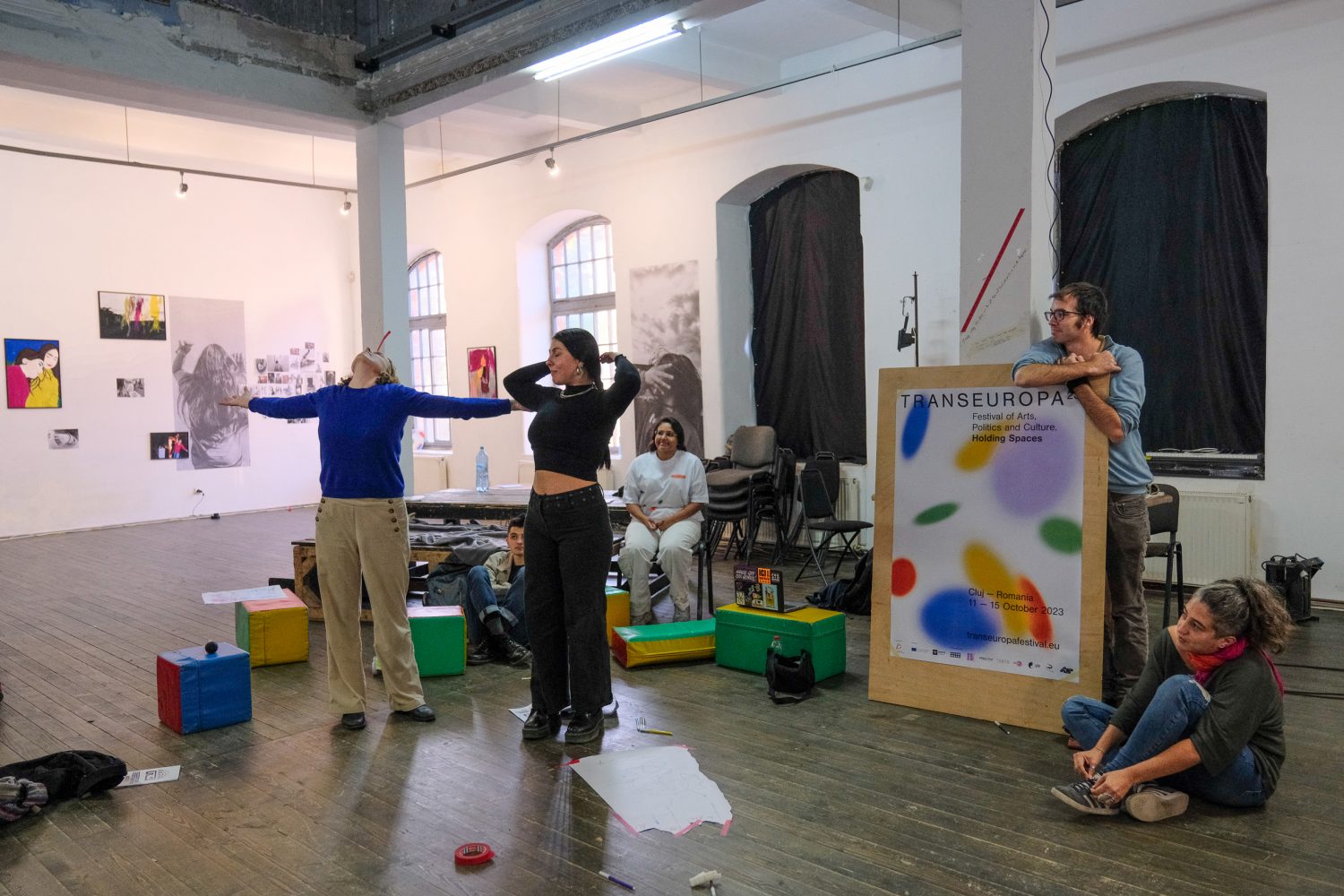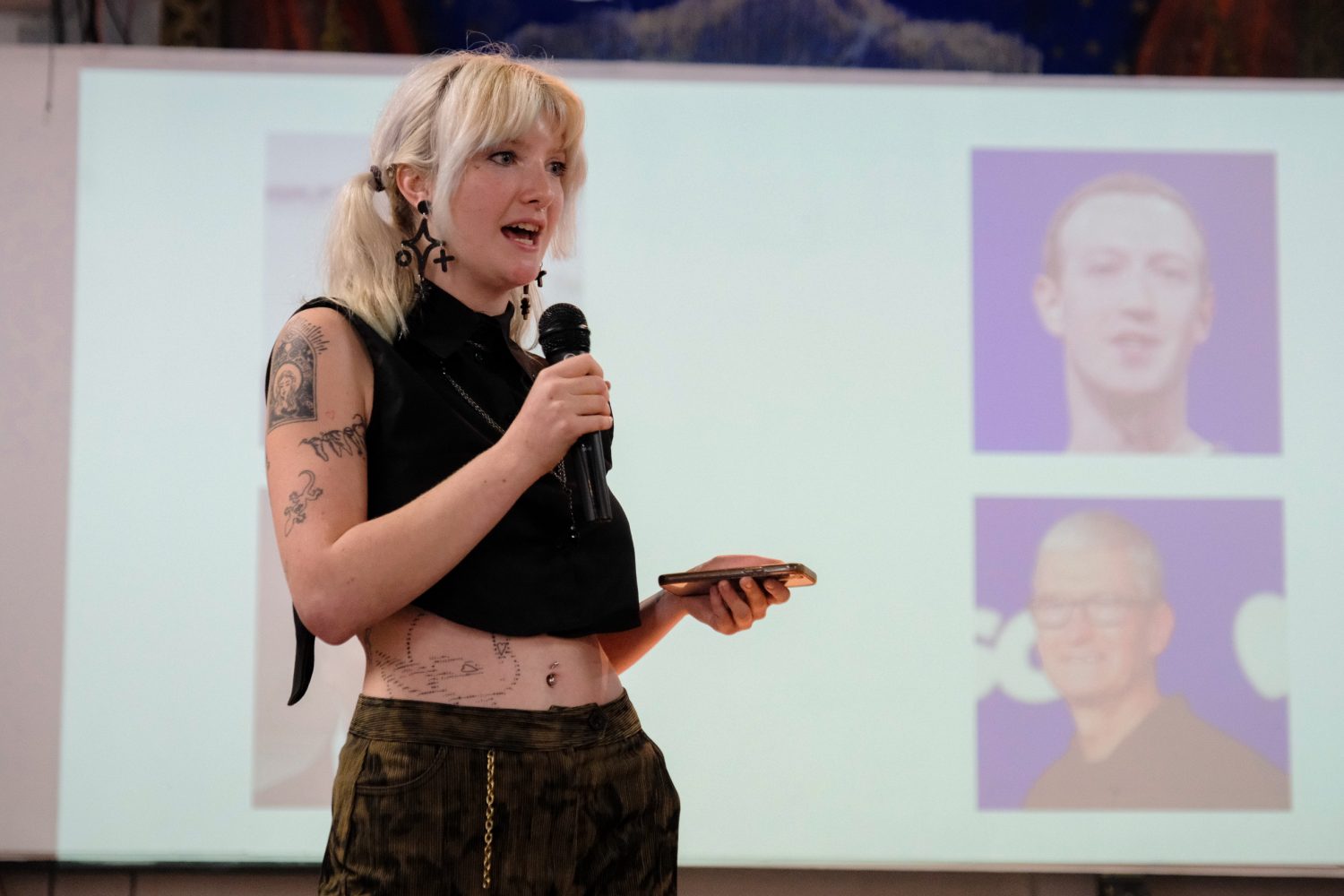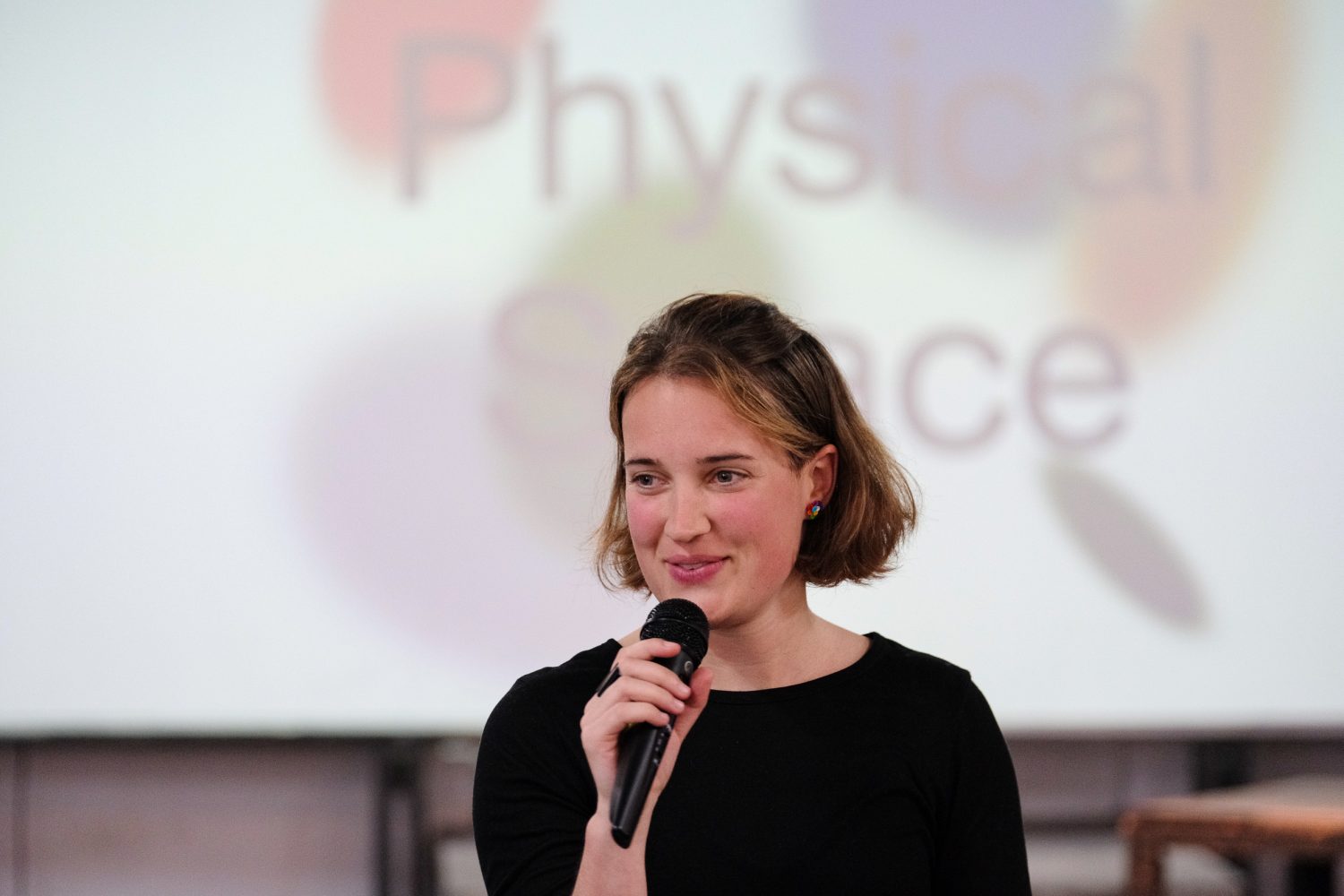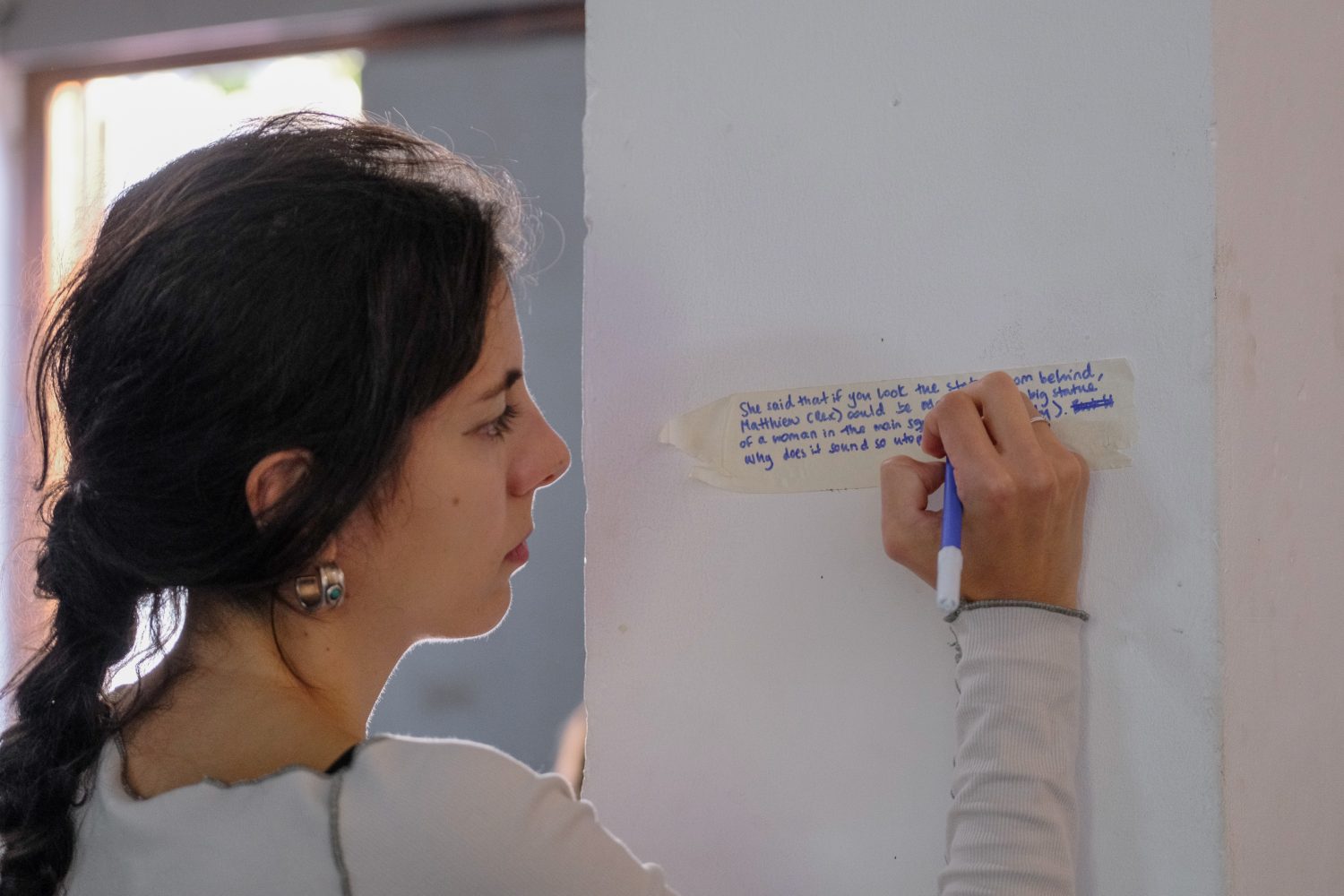Celia Fernández explores how the use of creative elements in political forums develops interaction and empathy, leading to greater awareness supportive of political change.
Cluj-Napoca, Romania. A group of local and international researchers, activists, and artists – from Spain, Greece, Sweden, Tunisia and elsewhere, – but also children and elders, gathered to discuss how they inhabit, are deprived of, or imagine the space they live in.



The participants are not strangers. They met five days earlier at the start of the Transeuropa Festival organised by European Alternatives. Each one of them is now carrying a stack of reflections sparked by the performances, exhibitions, and talks on the topic of space. Now, it’s time to assemble those impressions in a forum to reflect on who defines spaces – physical, virtual, and mental – and who they are defined for.
The Holding Spaces assembly is atypical – it could be thought of as a peculiar kind of citizens’ assembly. It is a place of discussion among citizens with different professional and geographical backgrounds to address issues that affect their lives from noon to doom. No policy recommendations advocating government action will emerge. Yet it could inspire citizens’ assemblies to become more relevant, creative, and democratic by using art as a vehicle for political change.
The blossom of citizens’ assemblies
A legitimacy deficit afflicts most of the world’s national governments. According to the EU’s Standard Eurobarometer conducted in June 2023, only 32 per cent of Europeans trust their parliamentary politicians. The consequences are manifold: less people turn out to vote; populist “them vs us” discourse finds its footing in all corners of society; and technocratic governments are advocated as the panacea. But among these, another response is blooming, which, in the words of politologist Hélène Landemore, is an “inclusive” and “participatory” model.
The citizen assembly, which dates back to Ancient Greece, is a group of residents selected by random sampling that comes together during a set period to read content and listen to experts on a specific topic, and discuss recommendations and deliver them to a government. Rather than attempting to win over others, citizens’ assemblies strive to devise a collective solution – a strategy of particular interest to the climate movement. Given sufficient time, resources, and expert assistance, citizen assemblies offer “one means to solve the problem of taking difficult, long-term decisions in a political system governed by short-term rules”, suggests editor Eva Talmadge in defence of citizens’ assemblies. Yet an element that tends to be conspicuously missing from climate citizens’ assemblies – and climate movement discussions in general – risks holding back the potential of such political forums. It is an element which is present, however, at the Holding Spaces gathering in Cluj: the use of art to further democratise politics.


Culture talks politics
Portraits of children living in slums on the outskirts of Cluj, the second largest city in Romania and an increasingly “trendy” spot, cover the Holding Spaces assembly walls. Since the early 2000s, gentrification led to successive waves of evictions that pushed many Roma residents to Pata Rât, also known as “Europe’s largest waste-related ghetto”. Most of the depicted children and families were evicted from the city centre in 2010, when local authorities forcibly relocated 350 people, mostly of Roma ethnicity.
Leaks from the landfill pollute the soil and the water in Pata Rât, and the leaked substances and the smoke of burnt waste can cause infections and diseases that often go untreated, as 80 per cent of Roma people in Cluj do not have a family doctor. Professional opportunities are typically precluded to residents of Pata Rât, which adds to their segregation. The situation is the result of longstanding structural violence and environmental racism against Roma communities, a phenomenon that is not exclusive to Romania.
The representations on the walls are more than photos: the children painted and wrote words over them in a workshop conducted by photographer Marion Colard. Beyond depicting the conditions where these children live, these representations go further by involving the children in interpreting their images, transforming them from passive subjects, reduced to their ethnicity, to active participants; they are humanized, just like the participants of this assembly, showing their distinct personalities, fears, and aspirations.
Someone could have simply told the story of the eviction, but it’s hard to imagine that it would have had the same impact on assembly participants as the visual and active representation of those deprived of space. In society’s binary terms, the saying goes: data speaks to the mind and art speaks to the gut. However, culture – which etymologically means “cultivation of the mind”– not only serves to uncover our emotional – often neglected – side but also enables understanding and deep connections in distinctive ways with the roots of a concrete situation or concept. At the Holding Spaces assembly, women from the Pata Rât community tell their story surrounded by images of landscapes that were so familiar to them, and became so to the rest of us. Some assembly participants write phrases that resonated with them on the walls. One sentence reads, “She said…Why don’t we deserve a normal house?” and one cannot help but think that this is more than an emotional reaction – it is a mindful action.
Art to reimagine the future
For citizens’ assemblies to foster balanced and meaningful conversations based on factual evidence, resources such as participation methodologies and scientific reports, as well as expert assistance, are extremely important. But the goal of climate citizens’ assemblies is to devise solutions, for which the capacity to imagine distant futures – an action ordinary to literature, theatre, and the visual arts – is paramount.
One of the workshops of Transeuropa festival was based on Theatre of the Oppressed methodology. For a couple of hours, assembly participants become simultaneously spectators and actors, experiencing different roles in an imaginary dispute about housing. She or he who five minutes previously was the person serving the eviction order becomes the evictee.
The goal of this type of forum-theatre – created by Brazilian theatre director Augusto Boal – is for participants to step out of their personal circumstances, project themselves in another situation and plan today what they would want to put in place for a better future. It is not solely about empathy with other people´s realities but also about strategising towards a desired outcome – exactly the remit of citizens’ assemblies. Yet so many forums still follow the traditional institutional processes, reduced to reading and talking.
As Mexican writer Jorge Volpi points out in Leer la mente (Reading the Mind), when our ancestors painted mammoths on caves or performed the movements of tigers to a crowd, they were preparing themselves for future scenarios. According to Volpi, fiction is not solely entertainment, but serves to the evolution of our species.
Art to enjoy politics
As Naomi O’Leary argues, citizens’ assemblies can suffer from a retention problem, and the time commitment required tends to filter out all but those who are already politically engaged. However, bringing the methodologies of diverse art forms into the equation would not only democratise access to knowledge – as performance or visual representation can simplify complex concepts – but also make forums more enjoyable and engaging. The inclusion of art would not prevent citizens’ assemblies from formulating recommendations to decision-makers. But in a context of growing polarisation and hectic politics, it could foster dialogue and ultimately reinvigorate democracy.
The Holding Spaces assembly comprises people with very different profiles, backgrounds, and ages. Although participants already shared a common sensibility towards politics and arts, the degrees of such and the reasons for their engagement varied. And, despite the burning issue being faced – the rampant privatization of public, virtual, and even mental space – the feel of the assembly is one of empathy, expectation, and hope.
The building where this unique gathering is taking place is a meeting place for artists, academics, and activists, but it was once a synagogue. While maintaining its structure and former decor, over the course of a decade, artists in Cluj have remodelled it into a space for diverse social, ethnic, and professional groups to encounter, talk, and empathise. Just like in this building, art can be the ally citizens’ assemblies need to engage more people, enable better dialogue, and ultimately change horizons.
Celia Fernández is PR and outreach associate at the Green European Foundation. She studied international relations, translation, and journalism and has written for various Spanish media outlets, including El País.